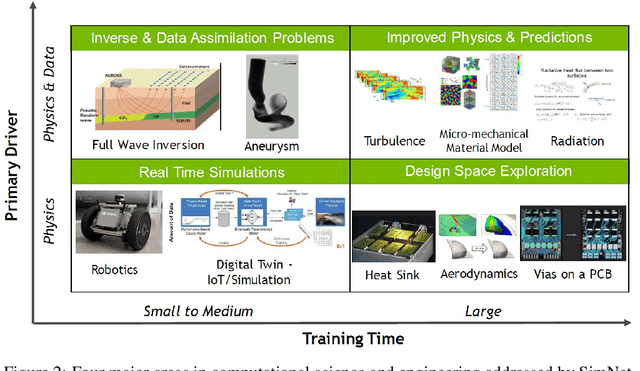Max Rietmann
Factorized Implicit Global Convolution for Automotive Computational Fluid Dynamics Prediction
Feb 06, 2025Abstract:Computational Fluid Dynamics (CFD) is crucial for automotive design, requiring the analysis of large 3D point clouds to study how vehicle geometry affects pressure fields and drag forces. However, existing deep learning approaches for CFD struggle with the computational complexity of processing high-resolution 3D data. We propose Factorized Implicit Global Convolution (FIGConv), a novel architecture that efficiently solves CFD problems for very large 3D meshes with arbitrary input and output geometries. FIGConv achieves quadratic complexity $O(N^2)$, a significant improvement over existing 3D neural CFD models that require cubic complexity $O(N^3)$. Our approach combines Factorized Implicit Grids to approximate high-resolution domains, efficient global convolutions through 2D reparameterization, and a U-shaped architecture for effective information gathering and integration. We validate our approach on the industry-standard Ahmed body dataset and the large-scale DrivAerNet dataset. In DrivAerNet, our model achieves an $R^2$ value of 0.95 for drag prediction, outperforming the previous state-of-the-art by a significant margin. This represents a 40% improvement in relative mean squared error and a 70% improvement in absolute mean squared error over previous methods.
Fast-SNARF: A Fast Deformer for Articulated Neural Fields
Dec 01, 2022Abstract:Neural fields have revolutionized the area of 3D reconstruction and novel view synthesis of rigid scenes. A key challenge in making such methods applicable to articulated objects, such as the human body, is to model the deformation of 3D locations between the rest pose (a canonical space) and the deformed space. We propose a new articulation module for neural fields, Fast-SNARF, which finds accurate correspondences between canonical space and posed space via iterative root finding. Fast-SNARF is a drop-in replacement in functionality to our previous work, SNARF, while significantly improving its computational efficiency. We contribute several algorithmic and implementation improvements over SNARF, yielding a speed-up of $150\times$. These improvements include voxel-based correspondence search, pre-computing the linear blend skinning function, and an efficient software implementation with CUDA kernels. Fast-SNARF enables efficient and simultaneous optimization of shape and skinning weights given deformed observations without correspondences (e.g. 3D meshes). Because learning of deformation maps is a crucial component in many 3D human avatar methods and since Fast-SNARF provides a computationally efficient solution, we believe that this work represents a significant step towards the practical creation of 3D virtual humans.
NVIDIA SimNet^{TM}: an AI-accelerated multi-physics simulation framework
Dec 14, 2020



Abstract:We present SimNet, an AI-driven multi-physics simulation framework, to accelerate simulations across a wide range of disciplines in science and engineering. Compared to traditional numerical solvers, SimNet addresses a wide range of use cases - coupled forward simulations without any training data, inverse and data assimilation problems. SimNet offers fast turnaround time by enabling parameterized system representation that solves for multiple configurations simultaneously, as opposed to the traditional solvers that solve for one configuration at a time. SimNet is integrated with parameterized constructive solid geometry as well as STL modules to generate point clouds. Furthermore, it is customizable with APIs that enable user extensions to geometry, physics and network architecture. It has advanced network architectures that are optimized for high-performance GPU computing, and offers scalable performance for multi-GPU and multi-Node implementation with accelerated linear algebra as well as FP32, FP64 and TF32 computations. In this paper we review the neural network solver methodology, the SimNet architecture, and the various features that are needed for effective solution of the PDEs. We present real-world use cases that range from challenging forward multi-physics simulations with turbulence and complex 3D geometries, to industrial design optimization and inverse problems that are not addressed efficiently by the traditional solvers. Extensive comparisons of SimNet results with open source and commercial solvers show good correlation.
 Add to Chrome
Add to Chrome Add to Firefox
Add to Firefox Add to Edge
Add to Edge